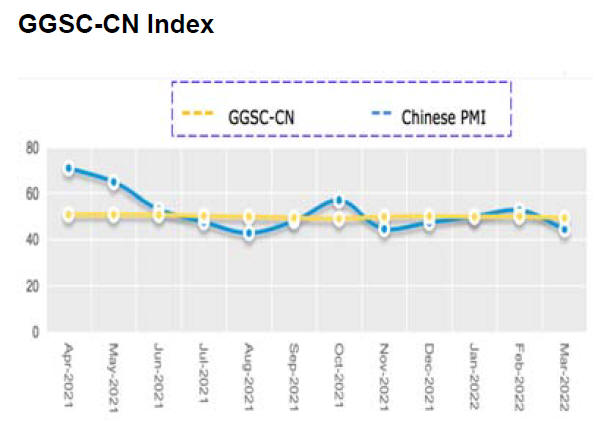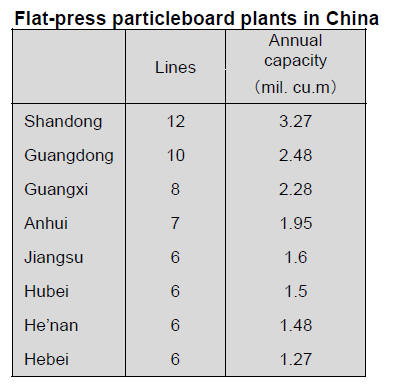US Dollar Exchange Rates of
10th
Apr
2022
China Yuan 6.3784
Report from China
Manufacturing output drops sharply
Manufacturers in China have seen output drop at its fastest
pace in two years as the economic impact of Russia¡¯s
invasion of Ukraine and new covid lockdowns bite. This
slowdown is likely to impact regional economies which
rely on trade with China.
To reduce the economic impact of covid restrictions the
government is adjusting its approach to reduce the time
that activities will be restricted suggesting there has been
some loosening of the Zero covid strategy.
The first round of large-scale covid testing was conducted
in Shuyang County of Jiangsu Province and many woodbased
panel manufacturers have ceased production.
Production of wood-based panels in Hebei, Jiangsu and
Shandong Provinces is now limited and it is difficult to
transport finished products or secure raw materials.
Adding to these challenges are the rising prices for fuel
and raw materials. However, wood-based panel
manufacturers in Linyi City, Shandong Province have said
although there is no great impact on production for now
many roads are closed which is a challenge.
Manufacturers revealed that transport costs from Guangxi
to Shanghai rose from RMB270-280 to RMB420 per
tonne. They also revealed that the price of raw materials is
still rising, for example the price for veneer rose from
RMB1,220-1,240 per cubic metre to RMB,1300 per cubic
metre recently.
In addition, demand is relatively weak and order levels are
lower this year. With weak demand it is difficult to raise
prices to off-set increased production costs.
GGSC-CN Index Report (March 2022)
In March 2022, as a result of covid control measures and
the impact of Russia¡¯s invasion of Ukraine, there has been
a marked impact on output. Production inputs are difficult
to secure, costs are rising and demand is weakening. The
overall economic growth rate has slowed.
In March China's PMI registered 49.5%, down from the
previous month and below the critical 50 mark indicating
that the macro economy has slowed. The development of
timber production and manufacturing industry also
showed a declining trend.
The new order index for most enterprises was lower than
the previous month and export orders dropped
significantly.
The GGSC-CN index for March registered 44.6% (71.9%
for last March and 70.7% for March 2020) and
was below the critical value of 50 indicating the operations
of the enterprises represented by GGSC-CN
index shrank from a month earlier.

Challenges: Covid infections have
reappeared, cross
province transport is disrupted and transportation cost
have increased.
Products in short supply: None.
Commodity of which the price has been increased:
methanol, melamine, paraffin, waterproof agent and other
chemical raw materials.
Commodity of which the price has been decreased:
eucalyptus firewood, pine firewood, melamine and urea.
Overview
In March 2022 two sub-indices of GGSC-CN increased
and three decreased.
The production index registered 50.0%,
a decrease from the previous month. The new
order index registered 33.3%, sharply down on
the previous month reflecting the inability of
enterprises to obtain orders.
The new export order index reflecting
international trade registered 25.0%, a decline
from the previous month indicating that orders
from abroad this month have fallen.
The main raw material inventory index
registered 58.3%, an increase from the previous
month. The employment index registered 50.0%,
an increase from the previous month.
The supplier delivery time index
was 41.7%, a drop from the previous month.
See:http://www.itto-ggsc.org/site/article_detail/id/237
Forest development plan 2021-2025
China aims to establish a modern forest and grass industry
system by 2025 with the total output value expected to
reach RMB9 trillion from RMB8.1 trillion in 2020. This
was included in the Forestry and Grassland Development
Plan (2021-2025) released by the State Forestry and
Grassland Administration.
China also strives to establish itself as a leading
country in
the international trade of forest and grasslnd products with
an annual import and export value hitting US$195 billion
by 2025 from US$152.8 in 2020.
The output of wood-based panels is expected to be stable
at around 300 million cubic metres, the output of flooring
at around 800 million square metres and the output of
wooden furniture at RMB800 billion by 2025.
More than 2 million hectares of national reserve forests
will be cultivated and upgraded by 2025. There will also
be a rise of 20 million cubic metres in annual stocking
volumes in national reserve forests. More than 8 million
cubic metres of stocking will be of rare tree species.
See:
http://www.forestry.gov.cn/main/304/20220221/110605840479828.html
China¡¯s bamboo industry
More than 500 Bamboo species grow in China being
distributed in 16 provinces or regions such as Fujian,
Jiangxi, Zhejiang where there are 7 million hectares of
bamboo forests.
At present, bamboo products are widely used in
construction, packaging, furniture, decoration and textils.
The bamboo industry plays an important role insupporting
rural economic growth and boosting incomes. In some
bamboo producing areas, such as Anji County, Huzhou
City in Zhejiang Province and Luzhou City in Sichuan
Province the bamboo industry has become a pillar of the
local economy.
The State Forestry and Grass Administration, the National
Development and Reform Commission and other
departments prepared a plan "Opinions on Accelerating
the Innovative Development of Bamboo Industry". This
was put forward to vigorously protect and cultivate highquality
bamboo resources, build a modern bamboo
industry system and create a beautiful rural bamboo
landscape.
See:
http://www.forestry.gov.cn/main/304/20220221/110605840479828.html
Rise in the fibreboard production capacity
Fourteen fibreboard production units were put into
operation nationwide in 2021 with an annual production
capacity of 3.36 million cubic metres. China's 376
fibreboard manufacturers had 425 fibreboard production
lines by the end of 2021 distributed in 24 provinces and
municipalities. The number of enterprises and production
lines in China's fibreboard industry declined while the
total production capacity and average single-line
production capacity increased as a whole.
About 33 fibreboard production lines were shut down,
dismantled or suspended operations in 2021 removing
around 4.56 million cubic metres capacity.
China had 142 continuous flat-pressing fibreboard
production lines by the end of 2021 with a total production
capacity of 30.37 million cubic metres per year accounting
for 57% of the national total fibreboard production
capacity, which distribute in 18 provinces and regions.

Eight production lines are expected to come on line
in
2022 with a production capacity of 1.93 million cubic
metres. The mills are in Eastern China such as Shandong,
Jiangsu, Anhui and Jiangxi Provinces as well as the
Guangxi Zhuang Autonomous Region of Southern China.
No fibreboard production lines are under construction in
North, Central, Southwest, Northwest or Northeast areas.
Of the new lines 7 are continuous flat-pressing production
lines adding an extra capacity of 1.78 million cubic metres
per year.
Rise in particleboard production capacity
13 particle board production lines were put into operation
in China in 2021 adding a further production capacity of
2.76 million cubic metres. China's 312 particleboard
production enterprises had 331 particleboard production
lines by the end of 2021.



|